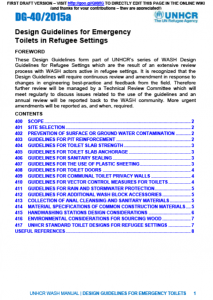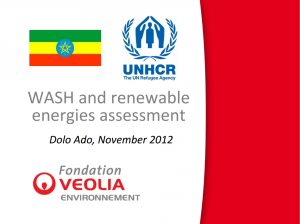Where required, UNHCR and WASH actors should work together to develop a site level refugee WASH strategy document that clearly describes the refugee context, the baseline WASH situation, WASH coverage, WASH gaps, along with short (6 months), medium (6 months – 5 years) and long-term (>5 years) strategies for each of the WASH sub-sectors and the twelve (12) WASH principles. This template can be used to help produce the site level WASH Strategy.
Archives
F-104/2015a UNHCR Site Level Refugee WASH Strategy Template (UNHCR, 2015)

UNHCR Country WASH Strategy Template (UNHCR, 2015)

Where required, UNHCR and WASH actors should work together to develop a country level refugee WASH strategy document that clearly describes the refugee context, the baseline WASH situation, WASH coverage, WASH gaps, along with short (6 months), medium (6 months – 5 years) and long-term (>5 years) strategies for each of the WASH sub-sectors and the twelve (12) WASH principles. This template can be used to help produce the Country level WASH Strategy.
F-102/2015a UNHCR WASH Organisational Capacity Assessment (UNHCR, 2015)

This tool has been designed to help obtain a snapshot capacity of national public, private, or refugee-based WASH service providers and understand the type of interventions that can be carried out to build capacity.
F-101/2015a UNHCR WASH Universal Access Checklist (UNHCR, 2015)

This document has been designed to help UNHCR and WASH actors assess WASH infrastructure for potential access from the individual perspective of each type of vulnerable user in particular persons with disabilities, women, children, and the elderly.
- Tags: Bathing Facilities and Laundering Facilities.
F-100/2015a UNHCR WASH Safety and Security Checklist (UNHCR, 2015)

This document has been designed to help UNHCR and WASH actors assess potential WASH related safety and security issues related to trip, crush, pinch, pierce, cut, splinter, burn, poison, electrocution, road traffic accident, drowning, and gender based violence.
- Categories: WASH Blank Forms, WASH Blank Forms, WASH Blank Forms, WASH Blank Forms, and WASH Blank Forms.
OG-802 Operational Guidelines for Staff Health and Safety in Refugee WASH Programmes (UNHCR, 2015)

This document provides health and safety guidelines for refugee WASH programmes for staff are involved in either: cleaning of toilets; maintenance of toilets; desludging of toilets; the collection and movement of excreta; the collection or movement of solid wastes; the handling of vector control or water treatment chemicals; any staff who may potentially come into contact with excreta, sewage, wastewater, solid waste, medical waste or any other sources of (potential) infection.
- Categories: WASH Operational Guidelines and WASH Operational Guidelines.
DG-400 Design Guidelines for Toilets in Refugee Settings (UNHCR, 2015)

This document contains guidelines for toilets in refugee settings including: site selection; prevention of surface or ground water contamination; pit reinforcement; toilet slab strength; toilet slab anchorage; sanitary sealing; use of plastic sheeting; toilet doors; privacy walls; vector control measures; rain and stormwater protection; wash block accessories; collection of anal cleansing and sanitary materials; material specifications; handwashing stations design considerations; and environmental considerations for sourcing wood .
- Tags: Communal Toilets, Communal Toilets, Excreta Treatment, and Household Toilets.
DG-300 Design Guidelines for Piped Water Networks in Refugee Settings (UNHCR, 2015)

This document contains guidelines to help UNHCR and WASH actors design piped water networks in refugee settings. It describes the minimum documentation that should be included for a water network design project.
Household Water Treatment and Safe Storage in Refugee Situations, (UNHCR, 2015)

This document contains guidelines to help WASH actors in refugee settings select household water treatment products. The document includes an overview of: • Categories of HWTS; • Health benefits; • When to use HWTS and existing decision tree; • Criteria regarding HWT to be considered by the field; • Mandatory components; • UNHCR Checklist for HWTS; • HWT concerns; • Household water treatment cards; • Safe water storage;• Further reading; • Acknowledgement
- Tags: Household Water Treatment and Water Quality Testing and Surveillance. Categories: WASH Guidelines, WASH Guidelines, WASH Guidelines, and WASH Guidelines.
Drinking Water, Sanitation and Renewable Energies Assessment – Dolo Ado Camp (Veolia Foundation and UNHCR, 2012)

This document looks at drinking water, sanitation and renewable energy solutions and options in three camps in Dolo Odo with recommendations and conclusions.
- Tags: Excreta / Urine ReUse, Excreta Composting, Excreta Management, Excreta Management, Solar Pumping, Water Supply, Water Supply, and Water Supply. Locations: Africa, Dollo Ado, East and Horn of Africa, and Ethiopia. Languages: English, English, English, English, English, English, English, English, English, and English. Organisations: UNHCR, UNHCR, UNHCR, UNHCR, UNHCR, UNHCR, UNHCR, UNHCR, UNHCR, UNHCR, and Veolia Foundation. Categories: WASH Reference Documents, WASH Reference Documents, WASH Reference Documents, WASH Reference Documents, WASH Reference Documents, WASH Reference Documents, WASH Reference Documents, WASH Reference Documents, WASH Reference Documents, WASH Research Documents, and WASH Research Documents.
 English
English
